Tactical missile system Hadès (France)
The development of the Hadès project (Hades is one of the names of the ancient Greek god of the underworld) began only in the mid-eighties, but by this time French specialists had already managed to conduct some research aimed at developing rocket technology. Back in 1975, shortly after the start of operation of the "Pluto", the military department formed requirements for the prospective OTRK. The defense industry conducted some preliminary research, but it did not go further. The country's leadership has not yet seen the point in replacing the existing complexes. The situation changed only at the end of the decade.
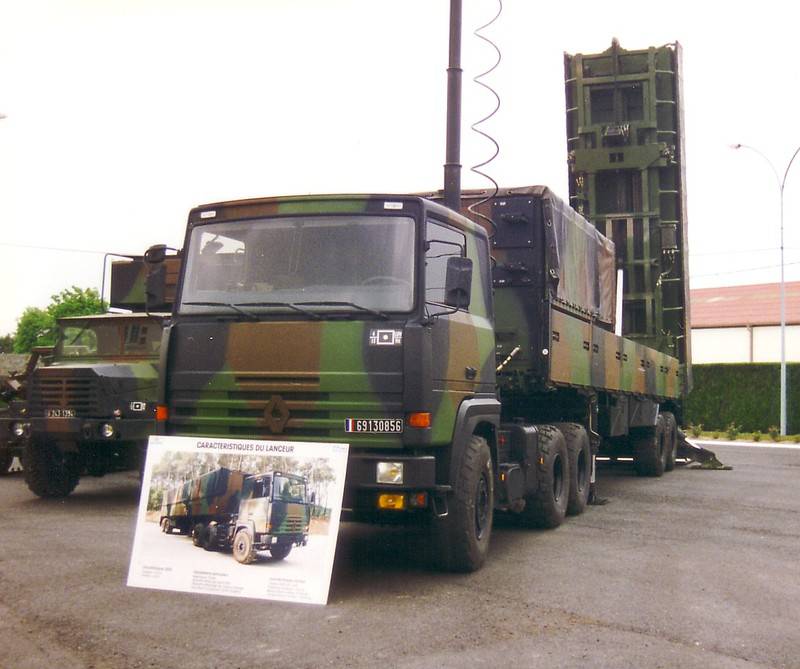
OTRK Hadès at the exhibition site. Photo Maquetland.com
At the very end of the seventies, the idea of modernizing the missile systems was returned. According to the analysis of the possibilities, it was later decided to create an upgraded version of the Pluton complex. The Super Pluton project was of great interest to the army, but was never brought to its logical conclusion. In 1983, the work was curtailed, because the simple development of existing technology was considered impractical. To meet the high requirements of the customer should have developed a completely new project.
The official launch of the new project called Hadès was given in July 1984. The order for the development of the complex was received by the company Aérospatiale. In addition, Space and Strategic Systems Division and Les Mureaux were involved in the work. At that time, the customer wanted to get an operational-tactical missile system with a firing range of up to 250 km. In total, it was planned to launch 120 missiles with a nuclear warhead. Subsequently, the requirements for the project were changed several times. For example, the military changed their mind about the type of warhead required, as well as increased the required range of fire. In the final version of the tactical and technical requirements, the latter was set at the level of 480 km - four times more than the "Pluto".
An analysis of the operational experience of existing missile systems, as well as the study of new requirements, led to the formation of the original appearance of a promising system. For certain reasons, it was decided to abandon the self-propelled tracked chassis based on tank and use a different technique instead. The most convenient in terms of operation and characteristics was considered a system in the form of a truck tractor and semi-trailer. On this technique, it was possible to place all the necessary components and assemblies, as well as ammunition in the form of two missiles. In addition to the acceptable carrying capacity, the tractor with a semi-trailer had to have high tactical and strategic mobility, allowing you to quickly transfer equipment to the desired area on existing roads. Losses in cross-country terrain were considered an acceptable payment for improving other characteristics.
The mobility of the new OTRK was to be provided by the Renault R380 tractor unit. This car with a wheel formula 6х4 had a bonnet layout and was equipped with a hp 380 diesel engine. The characteristics of the tractor made it possible to tow a special trailer with a complete set of various equipment and two missiles. Thus, with the total mass of the complex near 15, there was an opportunity to accelerate to 90 km / h on the highway. Cruising on fuel exceeded 1000 km. The use of a commercial tractor, as conceived by the authors of the Hadès project, should have given the complex certain advantages over existing systems.
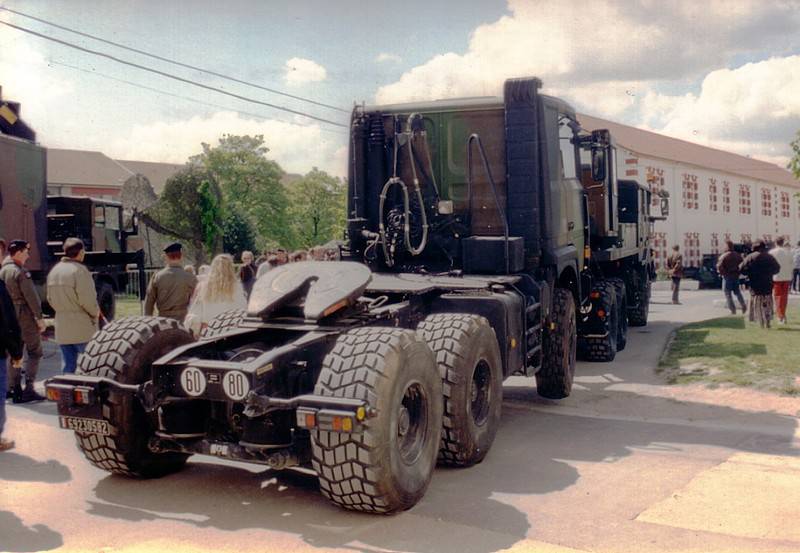
Tractor Renaulr R380. Photo Maquetland.com
The Hades project implied the use of a serial tractor with minimal changes in its design and configuration. In particular, a telescopic antenna was installed on the rear wall of the cabin for communication and reception of target designation. It was also envisaged to equip the driver’s workplace with some additional devices, such as means of communication with other crew members.
The main task of the towing vehicle was a special semi-trailer, which was an autonomous launcher for missiles. Outwardly, such a semi-trailer differed little from similar products used to transport various goods. The most noticeable difference in this was camouflage paint, obviously talking about the military purpose of the machine. However, all similarities with other semi-trailers were limited only by appearance.
The main element of the semi-trailer launcher was a power unit of great length, which had fastenings for all components and parts. On top of it were placed several elements of the hull, at the bottom - the chassis, the means of connecting with the tractor, etc. When using some of the elements borrowed from serial vehicles for transport purposes, the semi-trailer of the Hadès complex had a number of characteristic features directly related to its purpose.
In front of the semi-trailer, a large compartment-van was assembled with calculation work stations and various electronic equipment. For masking, the upper part of the sides and the roof of the calculation compartment were covered with a cloth awning. On the sides of the compartment of the van, there were low sides covering it. These boards ran along the entire length of the semi-trailer. In the central and aft parts of the board were used as a casing of various systems used with the rocking launcher. In addition, next to them were mounting to install and rockets in the transport position.
At the rear of the platform was a hinge for mounting the rocking frame of the launcher. The latter had a hydraulic drive for lifting and fastening for the installation of transport and launch containers of missiles. In the stowed position, the frame with the containers had to be laid in a horizontal position. In this case, the containers formed a kind of continuation of the roof of the compartment of the calculation. Due to the similar position of the units, the maximum similarity of the launcher with the cargo semi-trailer was ensured. For additional masking TPK missiles on the march was proposed to cover the awning.
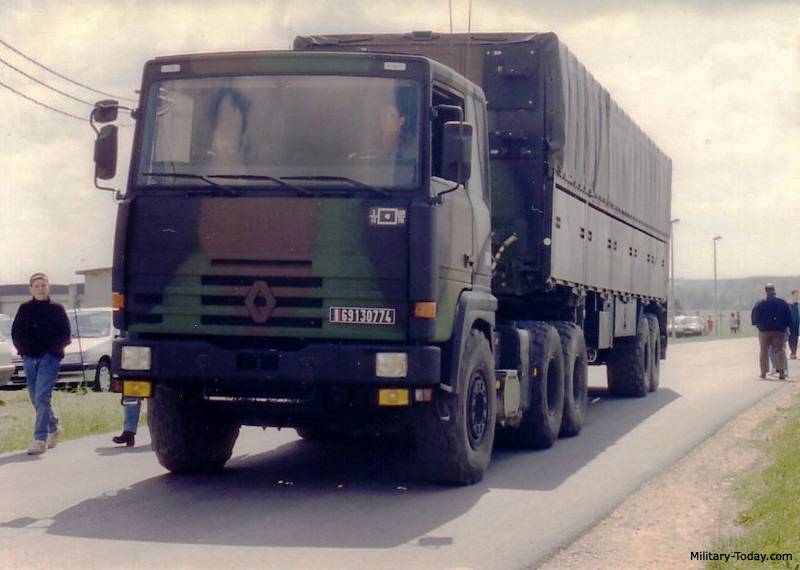
The complex is in a walking position. Photo Military-today.com
The semi-trailer received a “traditional” chassis based on a two-axle cart with gable wheels. Such a chassis could not provide the required stability of the launcher at the launch of the rocket, because of which the semi-trailer was equipped with a set of jacks. Two such telescopic devices with hydraulic drives were placed in front of the semi-trailer, directly behind the tractor. Two more supports were placed in the stern and fastened to the swinging arms, increasing the distance between them.
A three-man crew was to manage the tactical complex Hadès. The driver was located in the cab of the tractor. Two other crew members who were responsible for the use of rocket weapons, during the combat work were to be in the front compartment of the semi-trailer van. It was suggested to get into the compartment using the door in its front wall. Directly behind it were two chairs, in front of which there was a set of necessary consoles, controls, screens and indicators. Compute compartment did not differ in large size, but it contained everything you need and gave the desired usability.
The “Hades” OTRK had a total length of about 25 m, a width of 2,5 m and a height of about 4 m. The combat weight reached 15 t. Due to the sufficiently powerful engine and wheel chassis, the Renault tractor provided high mobility characteristics. Fighting vehicle could be transferred to the desired area as soon as possible. At the same time, movement over rough terrain was almost impossible.
One of the basic provisions of the Hadès project was the rejection of the further development of the existing Pluto system rocket, which had insufficient characteristics. For the new complex, it was decided to create other weapons. At the same time, however, the overall architecture of the new rocket corresponded to the developments in the previous complex. Again it was proposed to use a single-stage solid-fuel rocket with a special warhead and an autonomous guidance system.
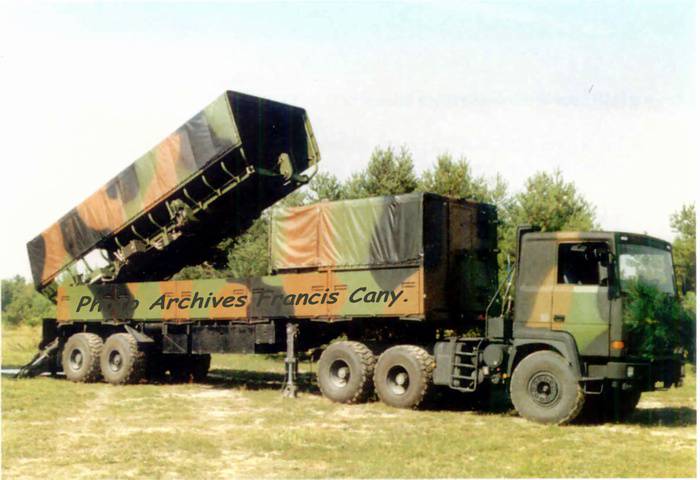
In the process of deployment. The jacks are lowered, the launcher rises. Photo Materiel-militaire.com
The rocket of the new model received a cylindrical body of large elongation with a lively head fairing. Next to the tail section were placed X-shaped stabilizers with rudders to control in flight. The layout of the product also remained the same. The head compartment was given under the placement of the warhead and control systems. All other hull volumes accommodated a solid engine with enhanced performance. The Hadès rocket had a length of 7,5 m with a case diameter of 0,53 m. The starting weight was 1850 kg.
To deliver the warhead to the target, it was proposed to use the solid propellant again. Due to the use of new fuel and the increased size of its charge, it was planned to achieve a significant increase in performance in comparison with existing analogues. In addition, the solid fuel engine did not impose special requirements for transportation, which was important for a mobile rocket system.
The basic version of the Hades project implied the use of an autonomous inertial guidance system. With the help of a gyro-stabilized platform with sensors, the automatics had to determine the movement of the rocket and its position in space, and then issue commands to the steering vehicles. According to the calculations, the circular probable deviation when using such guidance was to be 100 m. The possibility of using trajectory correction in the final segment using navigation satellite signals was also worked out. This made it possible to bring the QUO to 5 m. Like the rocket of the previous project, the Hadès product retained the possibility of maneuvering both on the active and on the final trajectory. The improved “satellite” guidance system has not left the stage of preliminary studies.
In the main compartment of the rocket should have been placed a thermonuclear warhead type TN 90. The development of this product was launched in 1983 year with a view to the future replacement of existing warheads used missiles. One of the main features of the TN 90 project was the use of a variable-power warhead. Depending on the type of target, it was possible to set an explosion power up to 80 kt. To solve some combat missions, the Hadès missiles could also use a high-explosive warhead of the same mass as the special one. This version of the rocket was easier to manufacture and operate, however, differed much less power.
The development of a completely new rocket allowed the customer to fully comply with the requirements of the firing range. The minimum distance to the target was determined at the level of 60 km, the maximum - 480 km. A characteristic feature of the rocket was the relatively small height of the trajectory. When firing at the maximum range, the rocket did not rise to a height of more than 150 km.
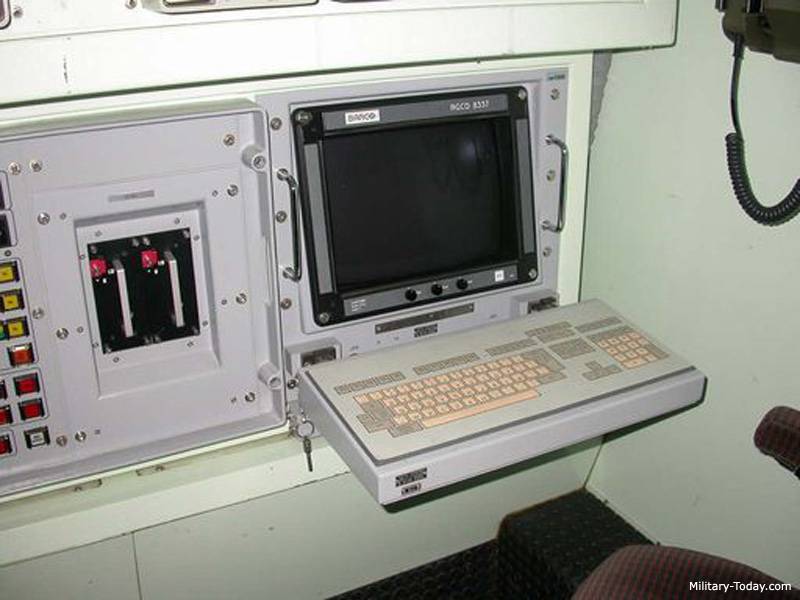
One of the consoles in the control compartment. Photo Military-today.com
It was proposed that the missiles of the Hades complex be placed at the factory in a transport and launch container and delivered to the troops in this form. The container was a rectangular product with a length of about 8 m with a width and height of about 1,25 m. On both sides, the container was closed with lids, protecting the rocket from various influences. On the lower surface of the TPK there were fastenings for mounting on the rocking frame of the launcher, as well as a set of various connectors. The dimensions of the container allowed one launcher to simultaneously carry two missiles simultaneously with a warhead of the desired type.
The process of preparing the complex for shooting was quite simple. Arriving at the specified firing position, the calculation of the OTKK Hadès had to hang out the launcher on the jacks, remove the tents, take their places and get information about the target from the command post. Then information about the required trajectory was entered into the automation of the missiles, after which it was possible to raise the launcher in a vertical position and give a command to launch. After that, all the responsibility for hitting the target was assumed by the onboard automaticity of the rocket. The crew of the complex, in turn, could use a second rocket or leave the position.
The development of the Hadès project lasted for several years. In 1988, a prototype of a new technology was presented for testing. At one of the French test sites, the running gears of the complex were tested, after which checks of the missiles began. During 1988, seven test runs were performed. All these checks were carried out with a single start. Complete the test was planned shooting full of ammunition, but this did not happen. For some reason, testers could not obtain permission to conduct such tests. However, the complex showed its capabilities and was recommended for use.
The possible military use of missiles was seen by the French military as follows. In the event of the start of a hypothetical conflict with the Warsaw Pact Organization, the PADC "Hades" should have become one of the means of defense of France on the long-range borders. The characteristics of this weapon made it possible to strike objects in the territory of the GDR and other countries-allies of the Soviet Union. In addition, attacks on an advancing enemy advancing on the territory of friendly states were not excluded.
After completion of the tests, the military department issued an order to industry for the production of serial equipment. Initially, during the beginning of the project development, it was planned to order several dozen launchers and 120 missiles. However, due to a change in the military-political situation in Europe, the order was reduced to 15 combat vehicles and 30 missiles for them. The warming of relations between the leading countries, the collapse of the ATS and other characteristics of that time made it possible to do without mass production of missile systems.
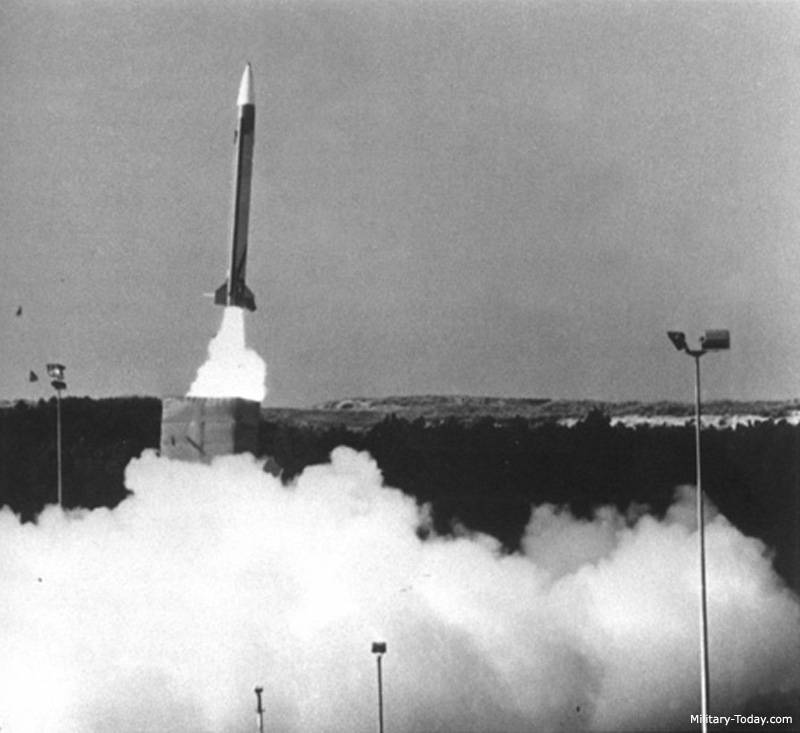
Start rocket. Photo Military-today.com
New equipment, produced in small quantities, received only 15-th artillery regiment, previously operated OTRK Pluton. The first cars of the new type were transferred to the regiment in 1992 year. Interestingly, the Hades complexes were never put into full operation. Back in September, French President Francois Mitterrand announced a refusal to introduce a new type of missile systems in September 1991. This technique was sent to the reserve. It was intended to be used only in the event of a serious danger.
By the middle of 1992, the industry had completed an order for 15 launchers and 30 missiles. After that, their production was curtailed and no longer resumed. All new vehicles and missiles for them were transferred to the 15 artillery regiment. Other compounds that were equipped with the Pluton system did not receive new equipment.
The appearance of the Hadès complexes allowed the French army to start writing off obsolete “Pluto” systems that no longer met the current requirements, and also did not fit into the current military-political situation. Soon, the 15 Artillery Regiment, which had stored the backup Hades, became the only unit of the French army with tactical missile systems.
OTK Hadès remained in reserve until the beginning of 1996, when the country's leadership decided to completely abandon such technology. In February, 96, the new president, Jacques Chirac, announced a radical reform of the French nuclear forces. Deterrence forces were now based only on submarine ballistic missiles and air-based missiles. All ground-based missile systems in this case were subject to write-off and disposal. Soon began the dismantling of mine launchers for strategic missiles and the disposal of operational-tactical complexes. The last Hadès missile was destroyed in June 1997 of the year. Two years later, the dismantling of all infrastructure facilities necessary for the use of such complexes was completed.
The tactical missile system Hadès could become one of the best systems of its class, which appeared in the nineties of the last century. Nevertheless, the harsh reality and geopolitical situation in Europe had a serious impact on the fate of this development. It was possible to bring the complex to mass production only in the early nineties, when the situation already allowed to do without such equipment. Later, Hades did not have a place in the renewed structure of the French nuclear forces. As a result, the entire short “career” of a dozen combat vehicles was to remain in storage, without formal commissioning and without real prospects.
On the materials of the sites:
http://military-today.com/
http://fas.org/
http://globalsecurity.org/
http://nuclearweaponarchive.org/
http://defence.pk/
Information